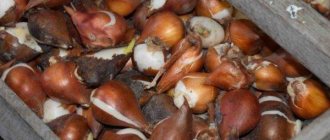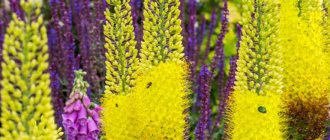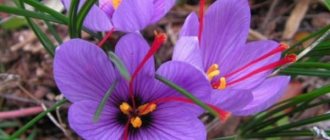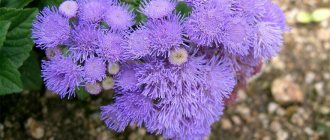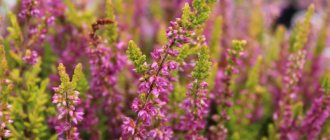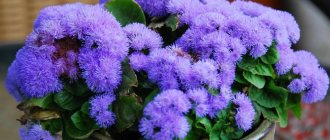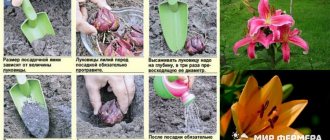Author: Elena N. https://floristics.info/ru/index.php?option=com_contact&view=contact&id=19 Category: Garden plants Published: February 13, 2019Last edits: October 18, 2021
- Where and when to plant
- Growing conditions
A drink from the heather Forgotten a long time ago. And he was sweeter than honey, Drunker than wine...
grass (lat. Calluna vulgaris) is an evergreen plant, the only species of the Heather genus of the Ericaceae family, which today numbers about 500 varieties, many of which have high decorative qualities. Heather grows in Europe, extending from the tundra to the coniferous-deciduous forest zone, in Greenland, North Africa, the Azores, temperate Asia and the Atlantic coast of North America, preferring forests, peat bogs and burnt areas. An old Scottish legend tells that heather was the only plant that agreed, at the request of the Creator, to grow on the bare rocky hills blown by the wind, as a reward for which it was endowed with endurance, unpretentiousness, a pleasant aroma and a modest but alluring charm. And to this day, where heather grows, nothing else grows - large areas covered with heather are usually called heather heaths. By the way, it was heather that gave the name to September in the Ukrainian, Belarusian and Polish languages - veresen, verasen, wrzesien.
Planting and caring for heather
- Planting: sowing seeds for seedlings is carried out at the end of March (or at the beginning of April), and two years later, the grown seedlings are planted in the ground in the second half of April (or at the beginning of May), but it is still better to do this at the end of September (or at the beginning of October).
- Flowering: July-August.
- Lighting: bright sunlight or light partial shade.
- Soil: wet peat or dry sandy soils with a pH of 4.5-5.5. Heather is not grown in limed soils.
- Watering: once every one and a half to two weeks.
- Humidity: higher than usual. In hot weather, the plant requires evening spraying.
- Feeding: in April or May with complete mineral fertilizer.
- Reproduction: by dividing the bush, apical cuttings, layering and seeds.
- Pests: practically not affected.
- Diseases: gray rot, powdery mildew, rust, viral infections.
- Properties: heather grass has wound-healing, cleansing, anti-inflammatory, diuretic, expectorant, disinfectant, anti-acid and soothing properties.
Read more about growing heather below.
Autumn or spring - when to plant heather?
When is it better to plant heather - in autumn or spring? Experienced gardeners have different opinions on this matter. Some say that planting in mid-spring is considered preferable. The reason is simple: during four to five warm months with consistently high temperatures, the shrub has time to gain a good foothold in the ground and sufficiently develop its root system. But here's the problem: the heat. Heather planted in the second half of spring often suffers greatly from the effects of high temperatures. And unfortunately, even regular watering does not help in 90% of cases.
The beginning of autumn is a completely different matter. It is believed that the ideal period for planting this strange shrub starts from the beginning of September and continues until the end of the first third of October. Typically this time period is characterized by stable temperature conditions. Frost is still a long way off. Therefore, the heather has time to both take root and adapt. Heat in early September, if it happens, is quite rare. In addition, it is no longer as sizzling as, say, in July or early August.
You should refrain from autumn planting only if you have chosen an outlandish imported variety of shrub. If the variety of heather that you want to plant is not afraid of low temperatures (most types of shrubs are frost-resistant), you can safely use all the tips and recommendations below - and plant heather in the first half of autumn. Rest assured, this is the best time to decorate your garden plot with a branchy plant.
There is a legend according to which the Creator invited plants to settle on the bare slopes of the mountains - where the soil is poor and infertile. The plants refused such a “tempting” idea. Almost everything - except the heather. For the courage and determination shown, the Creator gave heather a royal gift: he endowed the plant with an unsurpassed aroma that lures bees. And the result of the meeting of a bee and heather flowers is the already mentioned heather honey - an ancient recipe for beauty and youth.
Botanical description
The heather plant is a strongly branching, creeping evergreen shrub from 30 to 70 cm high with small triangular leaves, as if rolled into a tube, and small, fragrant, bell-like pink-purple flowers collected in one-sided brushes. Heather blooms in mid-summer, and reaches the peak of its beauty after the first frost, when its leaves acquire yellow and burgundy shades.
Heather was glorified in Robert Louis Stevenson's ballad “Heather Honey,” which we have known since childhood. And let someone think that the story described in poetry is fiction, but the fact that heather is an excellent honey plant, and the honey from it surpasses any other honey in healing qualities, is the true truth. Landscape designers prefer to plant heather along garden paths, on alpine hills, in borders, against the backdrop of dwarf conifers.
- Bells: planting and care, types and varieties
wild nature
Common heather is the name given to a pretty, beautifully flowering, hardy and most unpretentious shrub. It is believed that he set off on his journey around the world from Southeast Asia. Most often, these shrubs are found in pine, light mixed forests. Heather can choose peat or forest burnt areas. You can clearly see what heather looks like in the photo.
The plant is a bush of many shoots. They are densely covered with very small leaves of an unusual triangular shape. Heather shoots play with a variety of green shades. There are varieties of heather that have reddish leaves. There are unusual, attractive colors in muted copper, bright yellow or silver.
The small flowers of the plant are collected in dense inflorescences of six to thirty pieces. Usually in late summer - early autumn, the heathers are colored with deep purple, delicate pink, snow-white and even bright yellow. Under natural conditions, heather shrubs reach a height of approximately twenty-five centimeters.
An amazing long-living plant. There are specimens thirty and even fifty years old. They reach a diameter of more than three meters! In such a huge bush, the branches fall on the soil and take root, creating layering. But usually in nature, heather reproduces by seeds. Young bushes bloom when they reach the age of five years. Heather is an excellent honey plant that provides food for bees and many other insects.
Growing heather from seeds
How to sow seeds
Growing heather from seeds is a rather lengthy and labor-intensive process, but the high degree of seed germination - about 90% - inspires optimism. Heather seeds are placed in a bowl on top of a moistened substrate in a thin layer, without covering, and kept under glass until shoots appear.
The best substrate for germinating seeds is a mixture of coniferous soil, sand and peat in a ratio of 1:1:2. Crops need to be kept at a temperature of about 20 ºC, and for the first week it is necessary to create a high level of humidity for the seeds. Sprouts begin to appear after a month. As soon as the shoots appear, they begin to harden, briefly lifting the glass for ventilation. As soon as the seedlings grow and begin to interfere with each other, they are planted in containers or pots.
Seedling care
With the onset of summer, the seedlings are taken out into the garden and placed in partial shade, watering as needed, and with the onset of cold weather, the container is brought into a room where the air temperature is maintained within 10-12 ºC. Heather seedlings are planted in a permanent place after two years. It should be remembered that heather from seeds does not inherit its parental characteristics, but as a result of your efforts, a new variety may appear, which, quite possibly, will become your personal achievement.
Reproduction
Heather can reproduce vegetatively and generatively:
- vertical or horizontal layers,
- seeds,
- cuttings.
Seeds
Heathers reproduce by seeds in the wild. Sowing heather under amateur conditions is quite difficult. Not all heathers sow seeds; it is more convenient to grow them from horizontal layering or cuttings.
When growing heather from seeds, planting and care are carried out at home. It is better to sow heather seeds immediately after ripening. Freezing (stratification) of seeds significantly improves germination. Shoots appear after 1-2 months at 20 °C. Plants are potted when they reach a height of 1-2 cm. They should remain in a warm room during the first winter.
Horizontal layering
The lowest shoots take root easily when in contact with the soil. You can dig them in with soil, having previously secured them with a hook in the ground. When the shoots take root, it is enough to separate them from the mother plant and plant them in a new place.
Long-stemmed varieties can be propagated by layering. Summer is the best time to use this method.
Work progress:
- The soil around the bushes should be loosened. If it is very dry, you can add compost - moisture is necessary for root development. Heavy substrate should be mixed with peat and sand or vermiculite.
- Bend the outer shoots of the selected bush towards the ground. Those parts that will be covered with soil must be cleared of leaves.
- To speed up the rooting process, it is worth removing the bark from the underside of the center of the shoot, next to the node where the highest concentration of auxins is located - hormones responsible for plant growth. Uncut shoots will also take root, but much more slowly. The wound is lightly sprinkled with a rooting agent (for example, the drug "Kornevin"). Excess of the drug may prevent the plant from developing roots.
- The prepared shoot is bent at a right angle and secured with wire in a hole in the soil.
- Cover the hole with soil and tamp it down. The top of the shoot should rise vertically above the ground - this is a condition for the development of roots.
Horizontal layering does not require labor-intensive care, like cuttings. Taking care of them comes down to systematic watering. In the fall, you can replant rooted bushes.
Cuttings
Rooting of heather cuttings takes 3-4 weeks. The procedure is carried out in the summer - in mid-June.
Work progress:
- In summer, you can cut off several top shoots and plant them in a mixture of peat and coarse sand (in a ratio of 3:1).
- Make sure the mother plant is well hydrated before taking cuttings. Shoots intended for propagation should be 5-7 cm long. Before planting, we dip them in a rooting preparation, which will significantly speed up the process of root formation.
- The cuttings are placed in the substrate at a depth of 1 cm and watered.
There is no need to remove the lower leaves from the cuttings!
- Boxes with cuttings must be covered with film; without film, the seedlings will dry out quickly. The less time the cuttings spend under cover, the better - young plants are susceptible to fungal diseases. To avoid this, you need to avoid over-compacting the seedlings. You need to screw a wire frame onto the box, onto which you stretch the film. The film should not touch the plants. We systematically wipe away the water that condenses on the film. It is recommended to maintain relative humidity at 80-90%.
- Seedlings do not need to be irrigated; it is better to use drip irrigation. Additionally, it is worth carrying out preventive spraying with fungicides Rovral, Sumilex or Ronilan. The box with cuttings is kept in a shaded place. Until the cuttings take root, they are protected from sunlight.
- As soon as it is noticed that the roots begin to grow, slowly reduce the humidity. We gradually let in more and more light, harden the cuttings, and prepare the plants for winter.
- When new shoots appear on the seedlings, about 2-3 cm tall, the tops are cut off for better tillering. After 3 months, the plants are sufficiently rooted to plant them individually in pots.
- Seedlings overwinter better at temperatures not lower than -5 degrees Celsius.
- Next year, in the spring, they are put outside so that they gain strength and bloom. The seedlings are gradually hardened off before being exposed to direct sun. You cannot immediately plant unhardened plants in the sun - it will burn the tender leaves.
- After hardening, you can plant the seedlings in a permanent place in the garden, in properly prepared soil, flavored with acidic peat.
Planting heather in open ground
Where and when to plant
The best time for planting heather in open ground is from the end of September to the beginning of October and from the second half of April to the beginning of May, however, spring planting of heather is preferable to autumn. Heather loves open sunny areas, although it can grow in partial shade. Heather does not like calcareous soils, preferring dry sandy or moist peaty soils.
Heather does not pretend to make the soil fertile, but the pH value of the soil in the area should be shifted to the acidic side - pH approximately 4.5-5.5. The optimal soil composition for heather is peat, sand, coniferous soil or tree bark compost in a ratio of 3:1:2. The area where heather grows must be protected from strong winds. To acidify the soil, red high peat is added to it.
How to plant
Heather is planted at a density of approximately 6-10 specimens per 1 m², depending on the variety. The planting depth of the heather bush is 25-35 cm, the root collar should be flush with the surface of the site. If the soil on the site is clayey, in each hole you need to place a layer of drainage made of broken brick or sand with a layer of 5-10 cm. When planting heather, add 20-30 g of nitrophoska and 30-50 g of horn flour into the holes. After planting, water the heather seedlings at the rate of 5-6 liters of water for each heather bush and be sure to mulch the area with peat or coniferous wood chips. It remains to add that heather does not tolerate transplantation well, so try to think through all the steps and comply with all the requirements of agricultural technology so that the heather does not have to be replanted.
Conditions for growing crops in an open area
To grow heather, you need to become familiar with the optimal conditions for its cultivation.
Lighting and location selection
Before planting heather in the garden, you will have to find a suitable place for growing it. Many people believe that this plant is unpretentious in care and therefore grows anywhere, but this is not so. The flower is undemanding to lighting, and therefore it can be planted in shaded areas that are not always illuminated by the sun. When choosing a suitable place in the garden, pay attention to how it is blown by the wind.
The site must be reliably protected from wind gusts so that the seedlings do not break from strong winds.
Optimal temperature
The plant has poor frost resistance and therefore it is better to understand in advance the optimal temperatures for growing it. People who have been growing heather for many years recommend growing it in winter at temperatures of about 5-10 degrees Celsius.
To protect the bushes from hypothermia, the soil is mulched at the end of autumn.
The optimal temperature in summer is considered to be values that do not exceed twenty degrees above zero. Growing flowers near heat sources is contraindicated, since hot and dry air negatively affects growth and flowering.
Humidity
In order for the planted heather to grow and develop well, you need to monitor the level of humidity. In this case, special attention is paid to soil moisture. This is a moisture-loving plant that needs to be watered often. If the soil is too dry, the bush will begin to dry out. You also need to monitor air humidity. It is known that dry air negatively affects flower growth. Therefore, care must be taken to ensure that the air humidity is 80-90%.
Suitable soil
Experts advise planting heather in soils with a high level of acidity. If the acidity is too high, it is reduced with citric acid, peat or sulfur. You cannot grow bushes in alkaline soil, as they will quickly die.
The growth and development of heather is facilitated by micronutrients that should be contained in the soil. In order for the planted bushes to grow better, sand with peat and sawdust are added to the ground. You can also add 60-70 grams of sulfur to each plant, which accelerates the growth of heather.
The best and worst neighbors
People who have never grown heather are interested in which plants are best to plant it with. All varieties of northern orchids are considered good neighbors. If you plant them together with heather bushes, they will begin to bloom several weeks earlier than usual. Moreover, they will bloom 5-8 days longer. They can also be planted near pulmonary gentians, which bloom in early summer. Such flowers are considered tall, and therefore they should grow behind the heather.
Vegetable crops are considered bad neighbors because they consume a lot of nutritional components and slow down the growth of flowers.
Heather care
Growing conditions
The roots of heather are short and are not able to extract moisture from the depths of the soil, therefore, in the absence of regular rainfall, heather needs to be watered with acidified water - the soil on the site should be slightly moist at all times. It is this reason that makes it necessary to mulch the soil in the heather. In addition, mulch protects the soil on the site from overheating on hot days.
Watering is carried out once every one and a half to two weeks. After moistening the soil, it is advisable to loosen the soil to a depth of 10-15 cm while simultaneously removing weeds. Loosening and weeding are carried out through the mulch. In hot weather, heather can suffer from too dry air, so it responds well to nightly spraying.
As for fertilizing, every year in the spring (in April-May) complete mineral fertilizer should be added to the soil at the rate of 20-30 g/m² or 1.5-2 tablespoons for each adult plant. This is done in this way: dry fertilizer is scattered over the area, trying not to get on the leaves and flowers of the heather, otherwise burns may occur on them. Then the fertilizers are incorporated into the mulch, and the area is watered abundantly.
Heather needs annual spring pruning to maintain the desired shape and stimulate the growth of young shoots. However, intensive pruning of heather begins only in the third year from the moment of planting. Try to maintain the shape of the crown. The haircut is done as follows: hold the heather inflorescence by the top with your left hand, and cut off 2/3 or half of the inflorescence with your right hand. Vegetable trimmings can be shredded and scattered around the area as additional mulch.
Diseases and pests
Heathers are resistant to diseases and pests and are rarely affected, mainly by fungi or viruses. Most often, heather suffers from gray mold, and this occurs from stagnation of water in the roots, if the soil on the site is not characterized by good water permeability, and in the spring the snow melts too quickly. Gray rot manifests itself as a coating on the shoots, their death and falling leaves.
To combat the disease, heather is treated with fungicides, among which Fundazol and Topaz have the best effect, and in case of more severe damage, plants are sprayed with a one percent solution of copper sulfate. This treatment is carried out three times with an interval of 5-10 days. Good results are obtained by preventive spraying of heather with fungicides in the spring, after removing its cover, and in late autumn, before preparing the heather for wintering.
When heather is affected by powdery mildew, young shoots begin to dry out, and the leaves become covered with a whitish, loose coating. Red-brown spots on the leaves indicate heather rust infection. Both powdery mildew and rust are fungal diseases, so they need to be combated with fungicides, just like gray mold.
- Saving the harvest: 3 proven ways to protect seedlings from blackleg
If you notice deformed shoots or flowers on heather, if the color of flowers and leaves has become uneven and uncharacteristic for the heather variety, you are most likely dealing with a viral disease, which, alas, is incurable. Dig up the diseased bushes and burn them, and spill the place where they grew with a strong solution of potassium permanganate.
But if your heather grows on suitable soil and receives appropriate agricultural care, it will not be afraid of any diseases.
Heather propagation
We have already described the process of heather seed propagation to you. Heather also reproduces vegetatively - by dividing the bush, layering and cuttings. The apical cuttings are taken at the end of summer from the strongest non-flowering branches and rooted in pots with a mixture of sand and peat (1:3), maintaining the room temperature within 15-18 ºC, and the soil slightly moist. Once a month or a month and a half, feed the cuttings with a urea solution at the rate of 1 g per 1 liter of water and microfertilizers. In spring, rooted cuttings can be planted in open ground.
Heather often propagates itself by layering, without any effort on your part: over time, its old branches lie to the ground and take root on their own. If you want to carry out this type of propagation, bend the lowest of the mature shoots, pin them to the soil and cover with a centimeter layer of peat, and after a year, separate the finished seedling from the mother bush and transplant it to a new place.
The easiest way to propagate heather is by dividing the rhizomes. This can also be done at the end of summer: dig up a mature bush and, without clearing the roots from the soil, cut it into pieces so that each section contains young shoots and roots. Old stems are cut off before planting, and the cuttings are planted in separate holes, having previously treated the sections with crushed coal.
How to care?
The main care is regular watering, spraying the bushes in hot weather and formative pruning. The root system of heathers is compact. It has a large number of short branched roots, so plants cannot extract moisture from deep in the soil. We water the heathers with acidified water so that the top layer of soil is always moist. In summer, heathers suffer from dry air and respond well to spraying.
The first years after planting, heather does not need pruning. Later, in spring or autumn, after flowering, we cut off the old shoots with pruning shears. When pruning, we preserve the natural “shaggyness” of the bushes and the shape of the crown.
Fertilizing heather, as a rule, is not required, since in nature it grows on poor soils. For more luxuriant flowering, you can water the bushes with a solution of complex mineral fertilizer.
Not all varieties of heather winter well in the middle zone, so it is best to cover them in the fall. For them, a thick layer of sawdust, peat, pine or leaf litter is quite enough.
Heather after flowering
In warm areas, heather overwinters without shelter, but if you experience frosty winters, and even without snow, then it is better to play it safe and prepare the heather for wintering. To do this, after the onset of cold weather, spread peat around the heather bushes, and cover the bushes themselves with spruce branches, which will prevent them from freezing in winter, and in early spring will protect them from sunburn. Remove the cover from the heather in April.
Rated by man
An unpretentious and unusually attractive plant with its originality, heather has found wide use among urban landscape designers. It is grown with pleasure both in small gardens and in spacious summer cottages. This shrub looks harmonious with tall or dwarf conifers. Goes well with ferns, alpine plants, and berry crops. Forms cozy clearings under medium-sized deciduous trees. The photo below shows heather in harmony with spruce trees.
A shrub growing in natural conditions does not take more moisture from the surrounding soil than it needs to support its normal life activity. This unusual property of plants is called “physiological dryness”.
In small garden plots, heather looks great when placed in decorative containers, boxes and pots. This adds style to the decorative design of the garden plot.
It will fit well into the home interior as an unpretentious but beautiful indoor plant.
Types and varieties
There is only one species in the genus - common heather (Calluna vulgaris). Very often, heather is called the related erica, as well as its types and varieties, but no matter how similar erics are to heather, they are still different plants. The common heather species is represented by a huge number of beautiful varieties - today there are about five hundred of them. Gardeners divide them into six groups.
Group one. Varieties of heather with green leaf color:
- Allegro is an evergreen shrub up to 60 cm high and a crown diameter of about half a meter. The bark is dark brown, the crown is dense, compact, the leaves are dark green, scale-like. It blooms from late July to late October with simple, shiny carmine-red flowers in long inflorescences. The variety is winter-hardy and requires shelter for the winter only when young;
- Carmen is a Dutch hybrid variety, most popular in Europe. The crown is rounded, the height of the bush is 30-40 cm, the bark is dark brown, the leaves are small, dark green, the flowers are simple, violet-pink, on peduncles more than 10 cm long. It is winter-hardy, but it is better to cover it for the winter.
In addition to the described varieties of this group, Radnor, Duckness, Ross Hutton, Mazurka, Marco, Barnett Enley, Hookstone and others are also popular.
Group two. Varieties with green leaves and white flowers.
- Alba is an erect bush up to 40 cm tall with a crown diameter of up to 55 cm, with ascending branches, bright green leaves and dense clusters of white flowers;
- Alexandra is a spherical bush up to 30 cm high and a crown diameter of up to 40 cm with dark green leaves and creamy flowers, which acquire a dark red hue towards the end of flowering.
The following varieties of the group are also known: White Lon, Humpty Dumpty, Long White, Alec Martin, Alba Jay and others.
Group three. Varieties with silver leaves.
- Silver Knight is an English variety up to 30 cm high and a crown diameter of up to 45 cm with a compact, pillow-shaped crown, dark brown bark, fluffy, silver-gray leaves that take on a burgundy hue in winter. The flowers are simple, lilac or light purple, inflorescences up to 20 cm long. Winter-hardy, but in cold winters requires shelter;
- Peter Sparks is also an English variety up to half a meter high and up to 60 cm in diameter. The crown is oval, the bark is dark brown, the leaves are small, scale-like, dark green in summer and autumn, and gray-green in spring and winter. The flowers are double, dark pink, densely collected in inflorescences up to 30 cm long. Moderately winter-hardy.
Also popular varieties of this group are Annmarie, Velvet Fashion, Jan Dekker, Glendwick Silver and others.
Fourth group. Varieties with golden leaves.
- When to prune grapes - in spring or autumn? Depends on whether the grapes overwinter under cover!
- Andrew Proudley - up to 15 cm high and about 25 cm in diameter with thin, widely ascending branches. The leaves, which are orange with pale yellow tips in warm weather, take on a bronze hue in winter. Small pink flowers are collected in loose inflorescences;
- Boskup is a Dutch variety up to 40 cm high, up to 50 cm in diameter with a compact crown, dark brown bark, yellow-green leaves in the summer, which turn copper-red in the fall. The flowers are simple, pink-lilac, collected in short, slightly branched inflorescences up to 10 cm long. Moderately winter-hardy.
The varieties Aura, Arran Gold, Blazeway, Crimson Sunset, Gold Hayes, Cottswood Gold and others are also of interest.
Fifth group. Varieties with double flowers.
- Autumn Glow is a spreading shrub up to 30 cm high and a crown diameter of about 45 cm with branches rising at the ends. The leaves are dark green, densely double light purple flowers are collected in short dense racemes;
- Monica is a wide-spreading bush with a diameter of up to 80 cm and a height of about 55 cm. The branches are strong, widely ascending, the leaves are dark green, with a gray coating in winter. Very large double flowers in dense clusters of pinkish-red hue.
Other popular varieties: Red Favorite, Dark Star, Alba Plena, Joan Sparks, County Wicklow.
Group six. Varieties with indehiscent flowers.
- David Eason - a spherical bush up to 20 cm high and a crown diameter up to 25 cm, with numerous ascending branches, dark green leaves and dark mauve flowers collected in short racemes;
- Marlin is a German variety up to 30 cm high, crown diameter up to 50 cm. The bark is dark brown, the leaves are small, dark green. The never-opening buds are bright purple or lilac-pink.
Other varieties: Romina, Minima, Fritz Kircher.
Ericaceae
- Rhododendrons are unique and irreplaceable trees and shrubs with beautiful flowers and noble foliage. Most species bloom (Rh. “Northern Lihts”) in the first half of summer, and the leaves are decorative throughout the season.
- The winter hardiness of the following rhododendrons is considered to be quite high: deciduous - yellow (Rh. Luteus), Kamchatka (Rh. Kamtschaticum), Canadian (Rh. canadense), soft (Rh. Molle), Japanese (Rh. japonica); evergreen large-leaved rhododendrons - Caucasian (Rh. Caucasicum), Katevbinsky (Rh. catawbiense), Smirnov (Rh. smirnovii), short-fruited (Rh. Brachycarpum); evergreen narrow-leaved plants - rusty (Rh. ferrugineum), coarse-haired (Rh. Hirsutum); small-leaved semi-evergreen - Daurian, Ledebour (Rh. ledebourii); evergreen small-leaved – dense (Rh. impeditum).
Heathers and Erics
Common heather (Calluna vulgaris) is a low, multi-stemmed shrub with almost scale-like leaves and small lilac-pinkish flowers, often found in pine forests and along the edges of swamps. This evergreen plant blooms in autumn. There are varieties with pubescent leaves, with leaves colored in dark green, gray, yellow tones, as well as varieties whose leaves have an orange and reddish tint in winter, with different bush sizes and crown shapes. In spring, varietal heathers sometimes look damaged by the cold, but recover quite quickly and bloom successfully. In April, it is useful to cut out dried inflorescences from bushes. Ideal companions for rhododendrons and heathers are Erica - they occupy the lower tier of the composition and enliven it not only with bright blooms, but also with graceful needle-shaped leaves. Erica bushes are lower than heather and feel good in its shade even in sunny places. The most hardy in the frosty climate of the North-West is the blush - Erica ruddy, or meat red (E. carnea)
This charming shrub blooms in early spring and comes in varieties with white and pink flowers in a variety of colors.
Bright flowering attracts attention to the blush bushes in the spring, diverting attention from the varietal heathers gradually emerging from their winter state, sometimes damaged by the cold.
Forest low bushes
These include such well-known plants as wild rosemary (Ledum groenlandicum "Compactum"), bearberry, podbel (Andromeda) and berry bushes - cranberries, lingonberries, blueberries, blueberries. They fit perfectly into the composition of the coniferous-heather mixborder.
- Polyfolia (Andromeda polifolia), is widespread in the tundra and forest zones of Europe and America, but taken from nature, like all heathers, it takes root very poorly.
- There are several varieties (“Blue Ace”) of this unpretentious plant, differing in habit and flower color - from white to dark pink. Podbel usually blooms in early summer, sometimes again closer to autumn. It grows slowly, adding 3–5 cm per year depending on the variety.
- Acidic, even marshy soils and slightly shaded areas are suitable for podbela. Mulching, as for all heathers, is mandatory. In our area, the plant tolerates winter well and does not require shelter.
- Wintergreen (Gaultheria procumbens) is a very valuable, absolutely unpretentious, winter-hardy plant of North American origin. Grows slowly - up to 5 cm per year, can be used as ground cover. Evergreen, blooms all summer with small white and pink flowers. The red, lingonberry-like, inedible fruits remain on the shoots all winter. Wintergreen is planted in partial shade, on light acidic soils. Mulching is recommended; winter cover is not required.
- A coniferous-heather mixborder can be made even more attractive by adding berry bushes such as blueberries (Vaccinium corymbosum), lingonberries (Vaccinium vitis-idaea), cranberries (Oxycoccus palustris) and blueberries (Vaccinium myrtillus), including their modern garden varieties. Moreover, the first three plants need open, light spaces, but blueberries grow well only in partial shade.
Properties of heather
The medicinal properties of heather are in demand in both folk and traditional medicine. It is used to treat cough, kidney disease, cystitis, pyelitis, urethritis, dysentery, diarrhea, gastritis, enterocolitis, rheumatism, gout, and skin diseases.
Blooming heather is harvested from the end of June to September - it is at this time that it contains the maximum amount of useful substances: flavonoids, mineral salts of phosphorus, potassium, calcium and sodium, organic acids. These substances give heather a disinfectant, anti-inflammatory, diaphoretic, wound-healing, diuretic, expectorant, cleansing, astringent and soothing effect.
Heather decoction is used for insomnia and nervous system disorders, vascular atherosclerosis, gastrointestinal diseases, hyperacidity, cholecystitis and obesity. Inflammation of the mouth and throat is relieved by rinsing with a decoction, and for tuberculosis, an alcoholic infusion of heather is taken internally. Powder from crushed heather flowers is used to treat ulcers, wounds, eczema and burns. Heather baths are prescribed for radiculitis. An infusion of heather flowers, rubbed into the scalp, slows down the process of hair loss and improves its appearance.
Heather has no contraindications, but before taking medications from it, it is better to consult with an experienced doctor. It is not recommended to use heather internally for people with low acidity of gastric juice.



